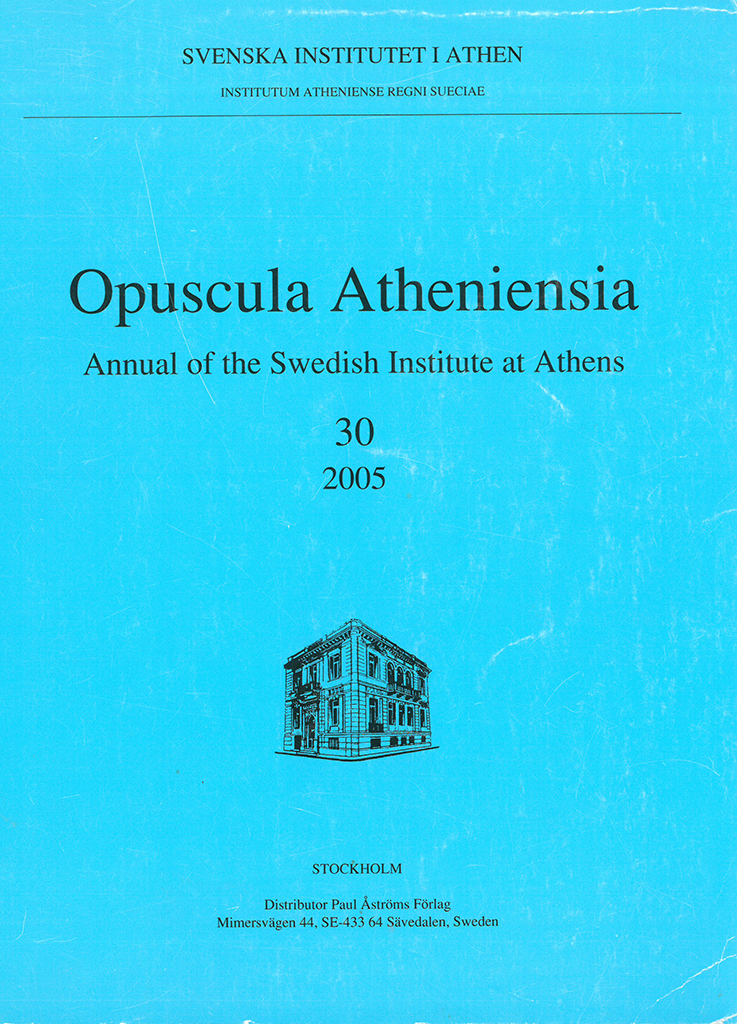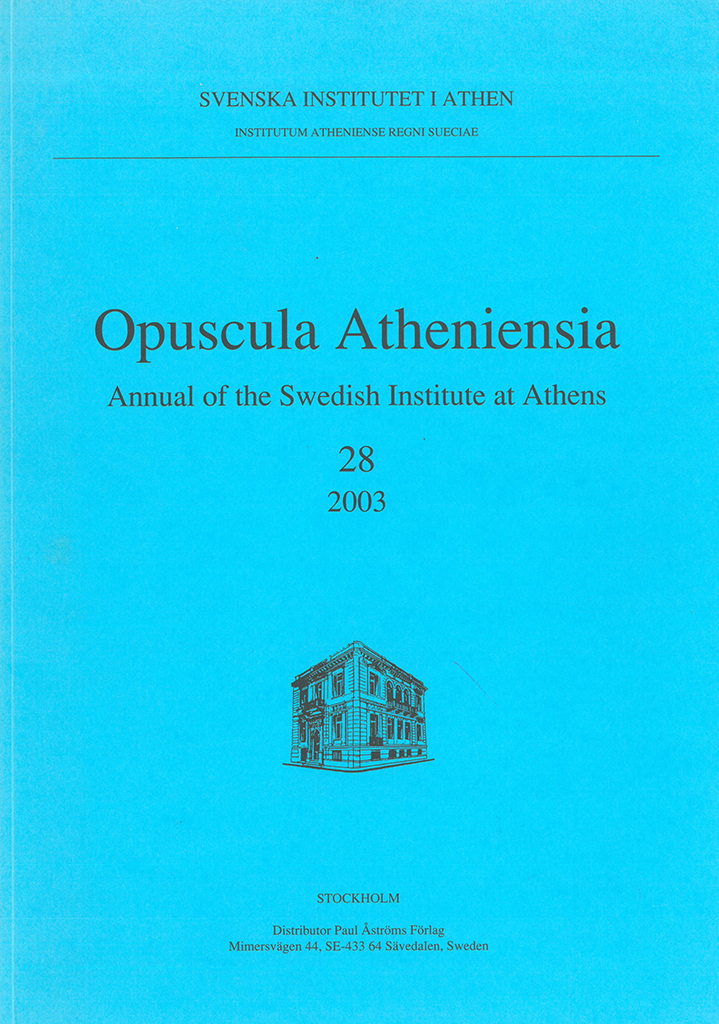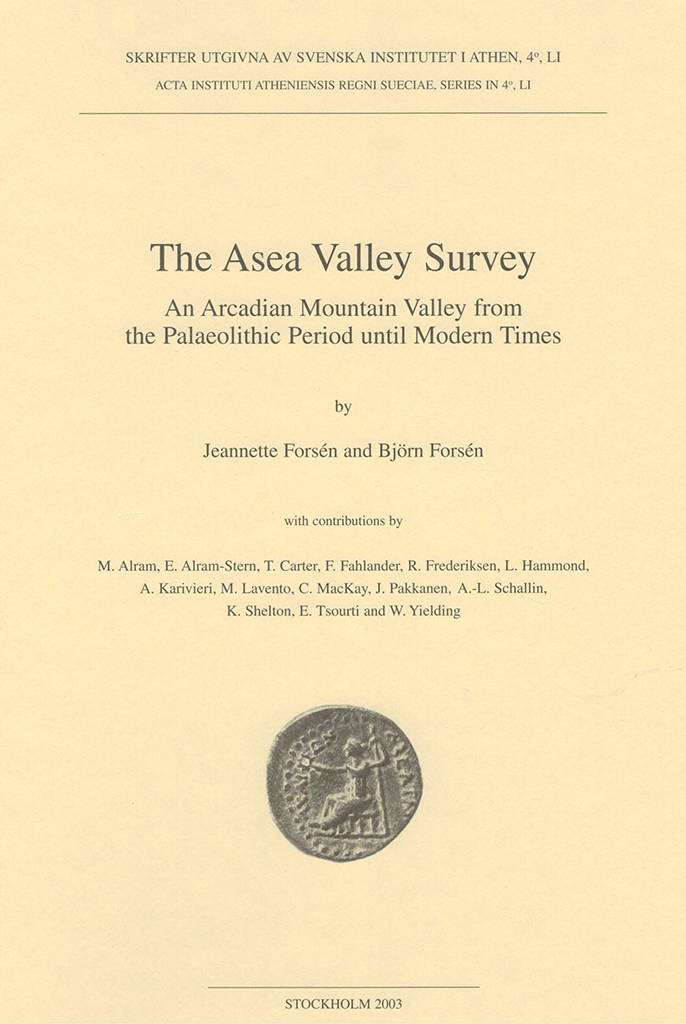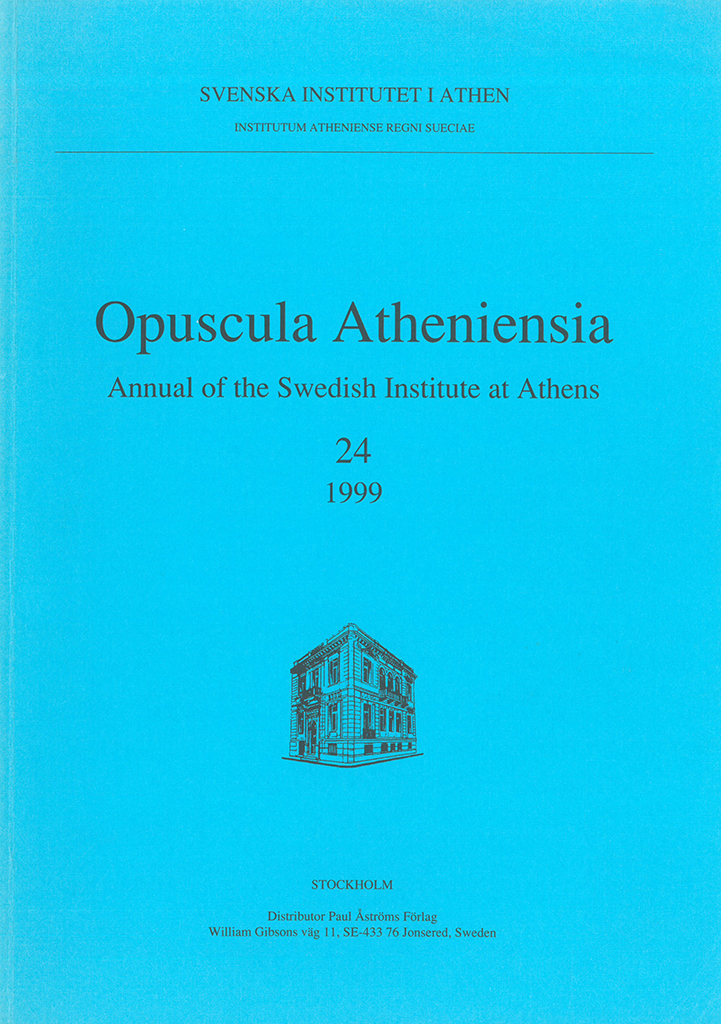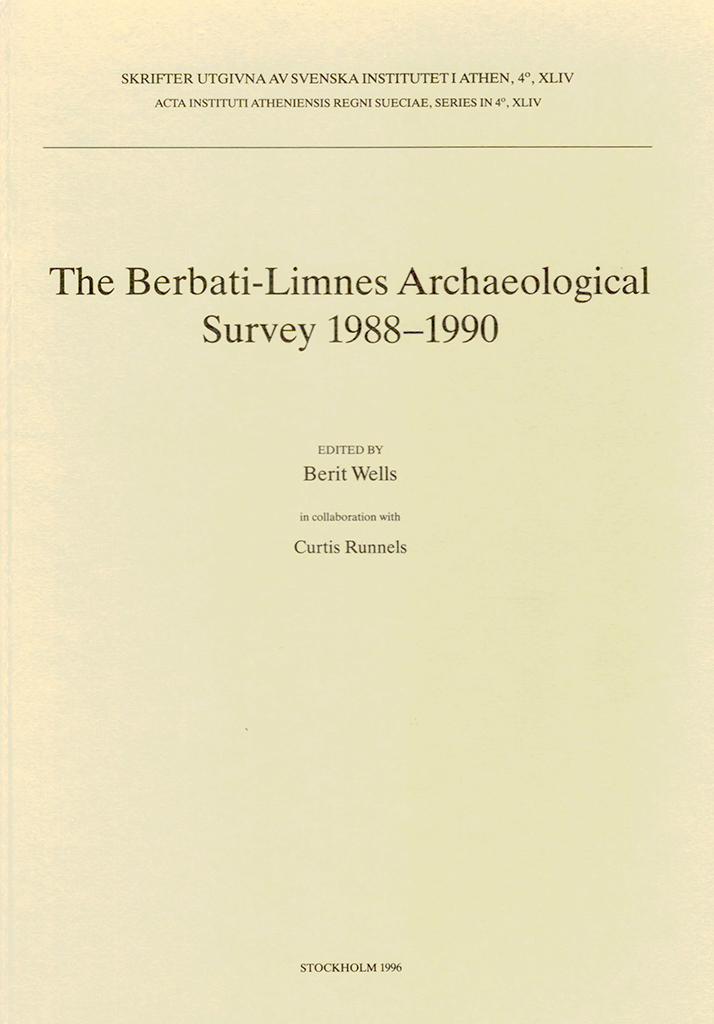Distributed by Astrom editions. Contents Katie Demakopoulou, Nicoletta Divari-Valakou, Ann-Louise Schallin, Lena Sjögren & Monica Nilsson | Excavations in Midea 2004 (pp. 7-34) Sandrine Ducaté-Paarmann | Images de la grossesse en Grèce ancienne: réflexions sur les modes de pensées et de comportements à l’égard du corps enceint (pp. 35-53) Johan Flemberg | A female canon: addenda (pp. 55-59) Niklas Hillbom | Minoan game markers, pieces and dice. Small archaeological finds that could have belonged to games and gaming (pp. 61-98) Eleni Mantzourani & Giorgos Vavouranakis | Achladia and Epano Zakros: a re-examination of the architecture and topography of two possible Minoan villas in east Crete (pp. 99-125) Berit Wells, Arto Penttinen, Jenni Hjohlman & Emanuel Savini | The Kalaureia Excavation Project: the 2003 season, with an appendix by Kristian Göransson (pp. 127-215) Book reviews Jeannette Forsén | S.L. Petrakis, Ayioryitika. The 1928 excavations of Carl Blegen at a Neolithic to Early Helladic settlement in Arcadia (pp. 217-218) Izabella Donkow | D. Parrish (ed.), Urbanism in Western Asia Minor: new studies on Aphrodisias, Ephesos, Hierapolis, Pergamon, Perge and Xanthos (pp. 218-221) Bibliographical information Opuscula Atheniensia. Annual of the Swedish Institute at Athens (OpAth) 3o, Stockholm 2006. ISSN: 0078-5520. ISBN: 91-7916-054-9. Softcover,…
Distributed by Astrom Editions. This volume of the Opuscula Atheniensia is dedicated to Pontus Hellström. Contents Katie Demakopoulou, Nicoletta Divari-Valakou, Ann-Louise Schallin, Erika Weiberg, Lena Sjögren & Monica Nilsson | Excavations in Midea 2003 (pp. 9-27) Izabella Donkow | A Hellenistic wreathed male head from Cyprus in the Museum of Mediterranean and Near Eastern Antiquities in Stockholm (pp. 29-38) Niklas Hillbom | The Knossos game board (pp. 39-71) Isabelle Ratinaud-Lachkar | Insoumise Asiné? Pour une mise en perspective des sources littéraires et archéologiques relatives à la destruction d’Asiné par Argos en 715 avant notre ère (pp. 73-88) Book reviews Søren Dietz | M. Lindblom, Marks and makers. Appearance, distribution and function of Middle and Late Helladic manufacturers’ marks on Aeginetan pottery (pp. 89-90) Carl Nylander | J. Boardman, Persia and the West: an archaeological investigation of the genesis of Achaemenid art (pp. 90-92) Paavo Roos | P. Debord & E. Varinlioglu (eds.), Les hautes terres de Carie (pp. 92-94) Renée Forsell | S.E. Alcock, J.F. Cherry & J. Elsner (eds.), Pausanias. Travel and memory in Roman Greece (pp. 94-95) Jan Olof Rosenqvist | C. Mango (ed.), The Oxford History of Byzantium (pp. 95-97) Books received (p. 98) The published writings…
Distributed by Astrom Editions. Contents Katie Demakopoulou, Nicoletta Divari-Valakou & Ann-Louise Schallin | Excavations in Midea 2002 (pp. 7-28) Berit Wells, Arto Penttinen & Marie Françoise Billot | Investigations in the sanctuary of Poseidon on Kalaureia 1997-2001 (pp. 29-87) Charles M. Adelman | The find group pottery from the Swedish excavations at Sina, Cyprus: significant sherds selected by Arne Furumark for his working notebook (pp. 89-171) Robert Parker | The problem of the Greek cult epithet (pp. 173-183) Birgitta L. Sjöberg | Settlement activity at Late Helladic Asine in the Argolid (pp. 185-201) Book reviews Lyvia Morgan | N. Marinatos, The Goddess and the Warrior. The naked goddess and Mistress of Animals in early Greek religion (pp. 203-204) Gunnel Ekroth | M. Deoudi, Heroenkulte in homerischer Zeit (pp. 204-207) Björn Forsén | Y.A. Pikoulas, Αρκαδια. Συλλογὴ μελετών (pp. 207-208) Björn Forsén | Y.A. Pikoulas, Λεξικό των οικισμών της Πελοποννήσου: παλαιά και νέα τοπωνύμια & F.A. Cooper (ed.), Houses of the Morea. Vernacular architecture of the northwest Peloponnesos (1205-1955) (pp. 209-210) Izabella Donkow | V. Tatton-Brown (ed.), Cyprus in the 19th century AD: fact, fancy and fiction. Papers of the 22nd British Museum Classical Colloquium, December 1998 (pp. 211-213) Books received…
Distributed by Astrom Editions. See record at WorldCat. The Asea Valley Survey. An Arcadian mountain valley from the Paleolithic period until modern times By Jeannette Forsén & Björn Forsén, with contributions by Michael Alram, Eva Alram-Stern, Tristan Carter, Fredrik Fahlander, Rune Frederiksen, Leslie Hammond, Arja Karivieri, Mika Lavento, Camilla MacKay, Jari Pakkanen, Ann-Louise Schallin, Kim S. Shelton, Eos Tsourti & Wendy Yielding This volume presents the finds of the Asea Valley Survey (AVS) carried out 1994–1996 in a mountain valley of Arcadia with the acropolis of Asea, the Palaeokastro, as its focal point. During these three seasons of archaeological surface survey 18.7 km2 of the valley were searched intensively in foot. Artefacts spanning from the Middle Palaeolithic period to the early 19th century were systematically collected and documented. Concurrently a geological team gathered data concerning the ever-changing landscape of the valley. By combining new archaeological and geological data with ancient, Byzantine, Ottoman and Venetian written sources the diachronic history of the Asea valley was reconstructed. Through the discovery of a Middle–Upper Palaeolithic site the regional history has been pushed back to about 50,000 BP. Furthermore, a handful of Early–Middle Neolithic lakeside sites, which produced nothing but chipped stone, may be…
Distributed by Astrom Editions. Contents Hans-Günther Buchholz | Arthur Milchhöfer, ein Verehrer und Führsprecher Schliemanns und “Die Anfänge der Kunst in Griechenland” (pp. 7-26) Katie Demakopoulou, Nicoletta Divari-Valakou, Ann-Louise Schallin, Gunnel Ekroth, Anna Lindblom, Monica Nilsson & Lena Sjögren | Excavations in Midea 2000 and 2001, with an appendix by Y. Bassiakos (pp. 27-58) Johan Flemberg | A female canon in Late Classical and Hellenistic sculpture (pp. 59-82) Jeannette Forsén, Björn Forsén & Lars Karlsson | The walls of Asea (pp. 83-104) Helen Mangou & Panayiotis V. Ioannou | Trends in the making of Greek copper-based artefacts during the prehistoric period (4000-1050 BC) (pp. 105-118) Gullög Nordquist | Pots, prestige and people. Symbolic action in Middle Helladic burials (pp. 109-135) Mirena Slavova | Mystery clubs in Bulgarian lands in antiquity. Greek epigraphical evidence (pp. 137-149) Helène Whittaker | Religion and power. The nature of Minoan influence on early Mycenaean religion (pp. 151-157) Book reviews Björn Forsén | E. Kourinou, Σπάρτη. Συμβολὴ στὴ μνημειακὴ τοπογραφία τησ (pp. 159-160) Johannes Siapkas | J. McInerney, The folds of Parnassos. Land and ethnicity in ancient Phokis (pp. 160-163) Paavo Roos | S.I. Rotroff, The Athenian Agora XXIX. The Hellenistic pottery: Athenian and imported wheelmade…
Published by the Swedish Institute at Athens. Distributed by Astrom Editions. New research on old material from Asine and Berbati in celebration of the fiftieth anniversary of the Swedish Institute at Athens Edited by Berit Wells After an introductory paper on the creation of a Swedish Archaeological School at Athens, ten papers deal with subjects associated with material excavated at Asine and Berbati in the Argolid before the new wave of excavations in the 1970’s. The following subject matters are discussed in relation to Asine: the emergence of an élite in the Middle Helladic (MH) period; pre-firing marks on MH Aeginetan pottery; wooden boxes used as coffins for infants in MH times; MH child morbidity and child mortality; Asine as a case of economic interaction in the Argolid; the provenience and alloy compositions of metal objects diachronically; the source of iron during the Geometric period; bridging the gap in settlement between 700 and 300 BC. Two papers are concerned with Berbati: one underlines the continuity of the Mastos settlement from Early Helladic II into EH III; and one lays out the possibilities for a detailed study of the provenience of the local Mycenaean ceramics. Contents Preface (p. 7) Berit Wells,…
Distributed by Astrom Editions. Birgitta Bergquist dedicata Contents Donald W. Jones | The archaeology and economy of Homeric gift exchange Donald W. Jones | The conundrum of Greek population growth in the 8th century B.C. Burials, settlements, and wells Jane F. Lloyd | The three-dimensional form of the light area of the Minoan hall system and the southeast corner of the South Hous at Knossos Jari Pakkanen | Defining the possible column shaft height range and profile. A case study based on the temple of Zeus at Labraunda Eva Rystedt | No words, only pictures. Iconography in the transition between the Bronze Age and the Iron Age in Greece Zofia Stos-Gale, Maria Kayafa & Noel Gale | The origin of metals from the Bronze Age site of Nichoria Lars Walløe | Was the disruption of the Mycenaean world caused by repeated epidemics of bubonic plague? Bookreviews Jeannette Forsén | E. Christmann, Die Deutschen Ausgrabungen auf der Pevkakia-Magula in Thessalien II. Die Frühe Bronzezeit Jeannette Forsén | J.B. Rutter, Lerna III. The pottery of Lerna IV Michael Wedde | K. Sbonias, Frühkretische Siegel. Ansätze für eine Interpretation der sozialpolitischen Entwicklung auf Kreta während der Frühbronzezeit Ann-Louise Schallin | Late Minoan III…
Distributed by Astrom Editions. View record at WorldCat. The Berbati-Limnes Archaeological Survey 1988–1990 By Berit Wells & Curtis Runnels (eds.) This volume presents the results of the surface survey carried out in the Berbati Valley and on the Limnes plateau for three seasons between 1988 and 1990. Both in ancient and modern times the two areas differ considerably both economically and politically, which in part is due to the natural environment, Prosímni (Berbati) lying in a fertile valley and Limnes in a mountainous district. The introductory chapter gives a general background to the project, introducing the two villages involved, presenting the objectives and setting out the methods employed in the field. For much of its history the Berbati-Limnes area depended upon external economic systems and powers. Thus the Final Neolithic–Early Helladic pastoral economy can be explained as part of the developments in the Balkans called the Secondary Products Revolution. These changes resulted in the catastrophic soil erosions which more or less depopulated the area at the end of the EH. The recovery was slow. Only towards the end of Middle Helladic does there seem to be a new beginning, which heralds intensive use of the area in the Late Bronze…

